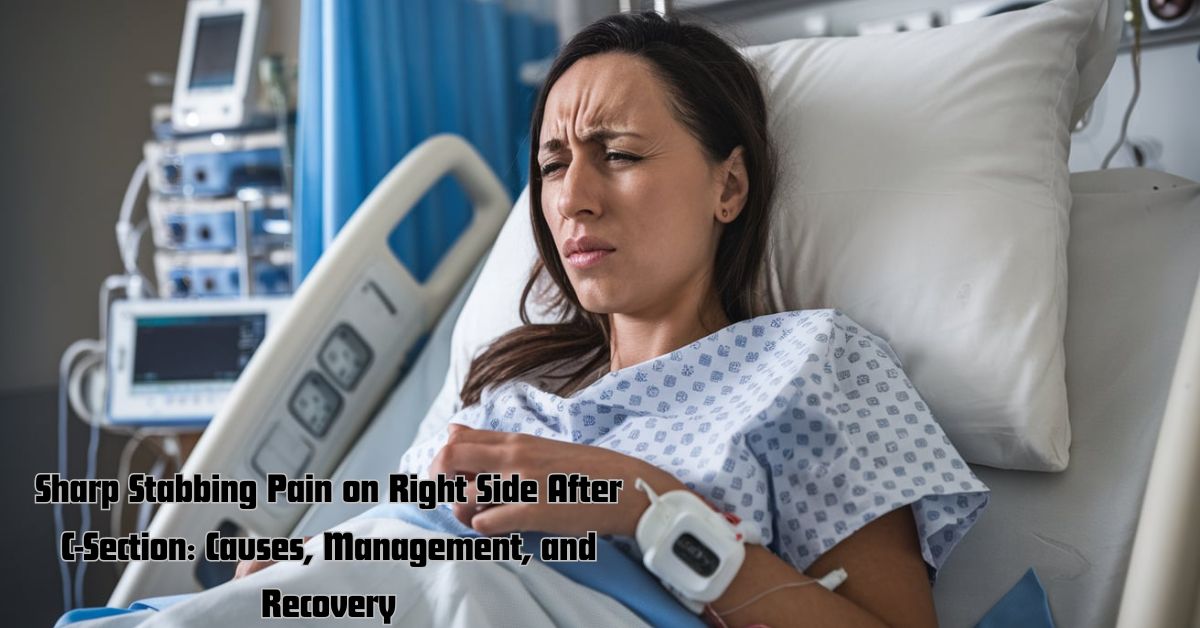Sharp stabbing pain on right side after C-section is a common concern for new mothers. This discomfort can range from mild to severe and may be constant or intermittent. Understanding the causes and management of this pain is crucial for a smooth recovery.
C-sections are major surgeries that require careful postoperative care. While some pain is normal, certain types of discomfort warrant attention. Recognizing the difference between expected healing sensations and concerning symptoms is key.
This article delves into the various aspects of right side pain after C-section. We’ll explore causes, diagnostic approaches, treatment options, and when to seek medical help. Our goal is to empower you with knowledge for a better recovery journey.
Understanding Post-C-Section Pain
C-section recovery involves dealing with different types of pain. The incision site is often the primary source of discomfort, but pain can also originate from deeper tissues. It’s important to communicate your pain levels clearly to your healthcare provider.
Sharp stabbing pain may indicate various issues. It could be related to the healing process, nerve irritation, or muscle strain. Sometimes, it might signal more complex problems like adhesions or infections.
Normal post-C-section pain typically improves over time. However, persistent or worsening pain, especially when accompanied by other symptoms, requires medical evaluation. Understanding your pain helps in determining appropriate management strategies.
Comparison of Pain Types After C-Section
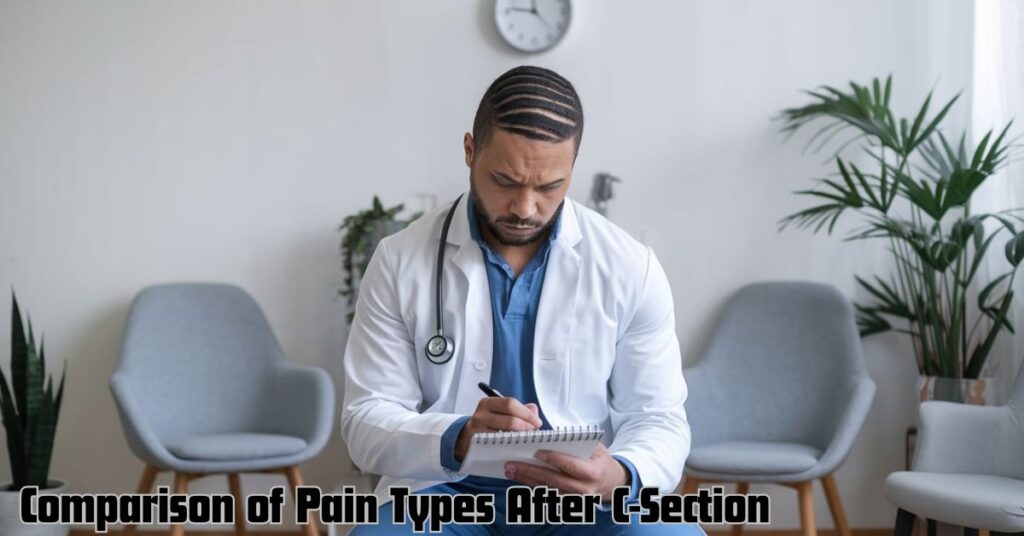
Understanding different types of pain can help you identify and communicate your symptoms more effectively. Here’s a comparison of common pain types experienced after a C-section:
| Pain Type | Description | Duration | Typical Location | When to Seek Help |
| Incisional Pain | Sharp, stabbing, or burning | 2-6 weeks | Along incision line | If worsening after 1 week |
| Nerve Pain | Electric shock-like, tingling | Varies, can be long-term | Radiating from incision | If persistent or severe |
| Muscle Pain | Aching, pulling sensation | 2-8 weeks | Abdominal area | If limiting movement after 2 weeks |
| Gas Pain | Cramping, bloating | 3-5 days | Upper abdomen, shoulder | If severe or persistent |
| Adhesion Pain | Sharp, pulling when moving | Can be long-term | Various abdominal areas | If interfering with daily activities |
This table provides a quick reference to help you identify different pain types. Remember, everyone’s experience is unique, and it’s always best to consult your healthcare provider if you’re unsure about your symptoms.
Pain patterns can change over time, and some women may experience a combination of these pain types. Tracking your pain and noting any changes can help your healthcare team provide the most appropriate care for your recovery.
Common Causes of Sharp Right-Side Pain After C-Section
Incisional pain is a frequent cause of sharp stabbing pain on right side after C-section. As the surgical wound heals, you may experience intense sensations, particularly in the first few days. This pain can be exacerbated by movement or touch.
Nerve pain resulting from surgery can cause electric shock-like or burning sensations. This type of pain may radiate from the incision site and can be temporary or persistent. Identifying nerve pain is crucial for targeted treatment.
Muscle strain is another common cause. The abdominal muscles cut during surgery need time to heal. Pain from muscle strain often increases with movement and can feel like a sharp pulling sensation. Gentle exercises can aid in recovery.
Distinguishing Normal Pain from Concerning Symptoms
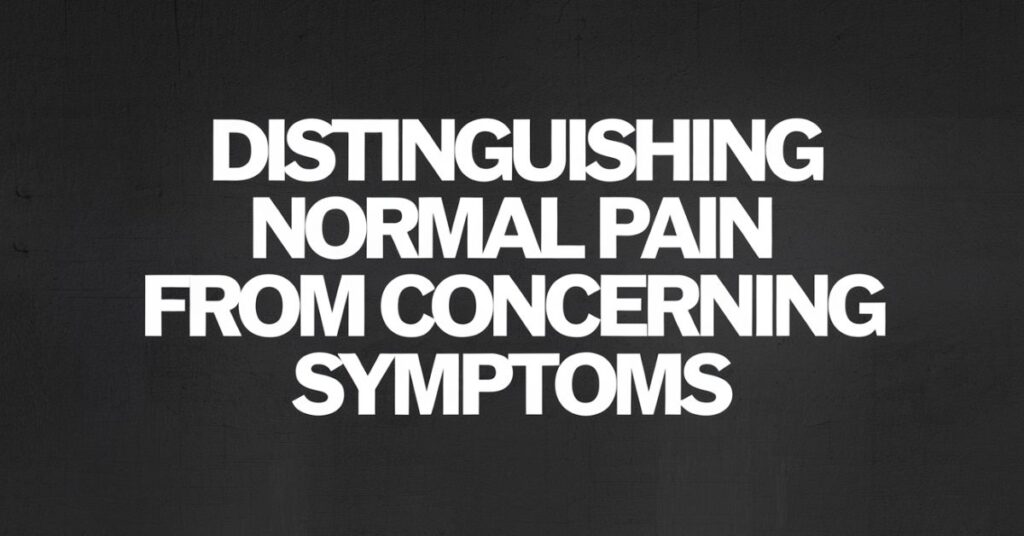
Normal post-C-section pain gradually decreases over time and responds well to prescribed pain medication. It typically improves with rest and gentle movement. This type of pain shouldn’t interfere significantly with daily activities or come with symptoms like fever.
Concerning symptoms include a sudden increase in pain intensity, pain accompanied by fever or chills, and severe pain unresponsive to medication. Pain associated with difficulty breathing or persistent beyond the expected recovery period also warrants attention.
It’s important to track your pain using a diary or pain scale. This helps in communicating effectively with your healthcare provider. Trust your instincts – if something feels unusually painful or “off,” don’t hesitate to seek medical advice.
Advanced Causes of Right-Side Pain Post C-Section
Abdominal adhesions, bands of scar tissue forming after surgery, can cause sharp, sudden pain. These adhesions may develop weeks or months post-surgery and often cause pain that varies in intensity. Treatment ranges from physical therapy to surgical intervention in severe cases.
Women with pre-existing endometriosis may experience flare-ups after a C-section. This can result in cyclical or constant sharp stabbing pain on the right side. Hormonal changes post-pregnancy can affect endometriosis symptoms, requiring specialized management.
Postoperative infections, though rare, can cause localized, sharp pain often accompanied by fever and swelling. Prompt treatment with antibiotics is crucial. In some cases, organ-related issues near the incision site, like appendix or gallbladder problems, may cause right-side pain.
Diagnostic Approaches for Right-Side Pain
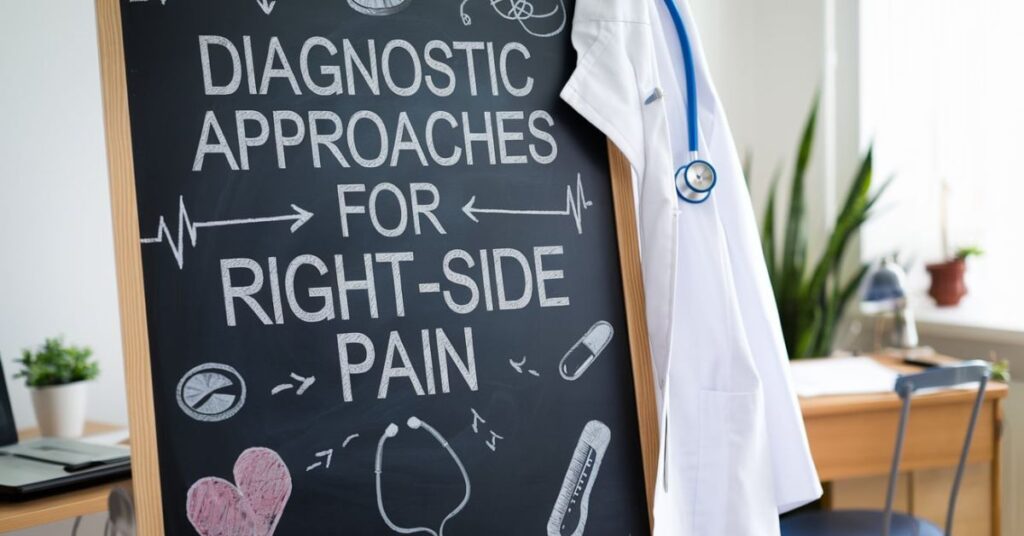
A thorough physical examination is the first step in diagnosing sharp stabbing pain on right side after C-section. Doctors check the incision site and surrounding areas for signs of infection, hernias, or other visible issues. The pattern and intensity of pain provide important diagnostic clues.
Imaging studies like ultrasounds, CT scans, or MRIs may be used to reveal hidden causes of pain. These can detect fluid collections, hernias, or deep tissue problems. Ultrasounds are often preferred for postpartum women due to their safety.
Blood tests help identify infections or inflammation. Elevated white blood cell counts may indicate an infection, while other markers can show general inflammation levels. In some cases, specialized tests like nerve conduction studies or laparoscopy might be necessary for a definitive diagnosis.
Treatment Options for Sharp Right-Side Pain
Medication management is often the first line of treatment. Over-the-counter pain relievers like acetaminophen or ibuprofen (after doctor’s approval) can help with mild to moderate pain. For more severe pain, prescription medications including stronger NSAIDs or, in some cases, opioids may be prescribed.
Physical therapy plays a crucial role in recovery. Techniques include gentle exercises to improve mobility, core strengthening, and manual therapy to break up scar tissue. A physical therapist can create a personalized plan tailored to your specific needs and recovery stage.
Alternative therapies can complement traditional treatments. Some women find relief through acupuncture, massage therapy, or heat/cold therapy. Mindfulness and relaxation techniques can also be effective for pain management. In rare cases, surgical interventions may be necessary for issues like hernias or severe adhesions.
Self-Care Strategies for Recovery
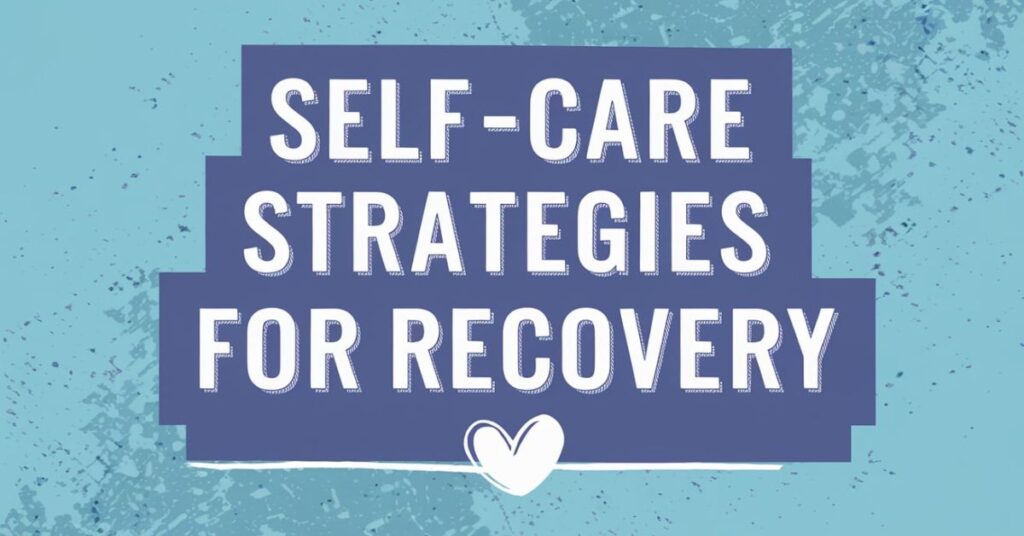
Proper wound care is essential in managing sharp stabbing pain on right side after C-section. Keep the incision site clean using gentle soap and water, patting dry thoroughly. Avoid applying creams or ointments unless prescribed, and watch for signs of infection like redness or unusual discharge.
Gentle movement and exercise aid recovery. Start with short walks around your home and gradually increase activity as pain allows. Avoid lifting heavy objects and use your arms for support when getting up. Gentle stretches can help relieve muscle tension and improve flexibility.
Supportive garments like abdominal binders can provide compression and support to the incision area. Use pillows for comfortable positioning while resting or feeding your baby. A balanced diet rich in proteins, fruits, and vegetables supports healing. Stay hydrated and include fiber to prevent constipation, which can increase discomfort.
Long-Term Considerations
Some women experience chronic pain after a C-section, persisting for months or even years. Factors contributing to chronic pain include nerve damage, adhesions, or improper healing. Early intervention and management are crucial in preventing pain from becoming chronic.
A history of C-section can affect future pregnancies. The risk of complications in subsequent pregnancies may increase, and decisions about vaginal birth after cesarean (VBAC) or repeat C-sections need to be discussed with your healthcare provider. Each case requires individual assessment.
C-sections can have lasting effects on abdominal muscles and core strength. Long-term exercise programs can help restore abdominal strength and function. Some women may experience changes in sensation around the incision area, which can be temporary or permanent. Scar tissue management techniques can improve skin texture and sensation.
Emotional Impact and Mental Health
Dealing with prolonged pain after a C-section can be emotionally challenging. It’s normal to feel frustrated, disappointed, or anxious about your recovery. Acknowledge these feelings and seek support when needed. Setting realistic expectations for your recovery is important.
Building a strong support network is crucial. This can include family, friends, and healthcare providers. Don’t hesitate to ask for help with baby care and household tasks. Connecting with other C-section moms through support groups or online forums can provide valuable emotional support and shared experiences.
If pain is significantly affecting your mental health, consider seeking professional help. Postpartum depression and anxiety can be exacerbated by physical discomfort. Therapists experienced in postpartum issues can offer coping strategies and support to navigate this challenging time.
Read this Blog: The Essential List of Co-Parenting Boundaries Every Parent Needs
Prevention Tips for Future C-Sections
If you know you’ll have a C-section, prepare your body beforehand. Strengthening core muscles can aid in faster recovery. Discuss any concerns with your doctor and understand the procedure to reduce anxiety. Ask about pain management options available to you.
Follow postoperative care instructions carefully. Take prescribed medications as directed and don’t skip doses, even if you’re feeling better. Early mobilization, as advised by your doctor, promotes healing and prevents complications. Listen to your body and avoid overexertion.
Maintain a healthy lifestyle before and after pregnancy. A balanced diet and regular exercise can reduce the risk of C-section complications. If you smoke, quitting is crucial as it can impair healing and increase infection risks. These lifestyle factors contribute significantly to overall recovery and long-term health.
When to Seek Emergency Care
Severe, sudden, or unmanageable pain requires immediate medical attention. This could indicate serious complications like internal bleeding or infection. Don’t ignore pain that significantly worsens or changes in character.
A fever over 100.4°F (38°C) warrants urgent care, as it could signal an infection. Similarly, excessive bleeding, such as soaking through a pad in less than an hour, is a red flag. These symptoms require prompt evaluation to prevent serious complications.
Difficulty breathing or chest pain needs immediate medical assessment. These could be signs of a pulmonary embolism, a rare but serious complication. Also, watch for signs of infection at the incision site, including redness, swelling, or unusual discharge. Early treatment of infections is crucial for preventing more severe problems.
Bottom Line
Dealing with sharp stabbing pain on right side after C-section can be challenging, but remember that recovery is a process that takes time and patience. Don’t hesitate to reach out to your healthcare provider with concerns. Early intervention often leads to better outcomes.
Focus on self-care and celebrate small victories in your recovery journey. With proper care and attention, most women fully recover from C-sections. Stay informed and proactive in your recovery, as your health and well-being are crucial for both you and your new baby.
Remember, you’re not alone in this journey. Many women experience similar challenges after C-sections. By staying informed, seeking support when needed, and following your healthcare provider’s advice, you can navigate this recovery period successfully and focus on bonding with your new baby.
Frequently Asked Questions
How long is it normal to experience sharp pain after a C-section?
Some sharp pain is normal for 4-6 weeks. Persistent or worsening pain beyond this period needs medical attention.
Can sharp right-side pain indicate a serious problem?
Yes, it could signal complications like infection or hernia. Seek prompt medical evaluation if pain is severe or accompanied by other symptoms.
Is it safe to exercise with right-side pain after a C-section?
Light exercise can be beneficial, but consult your doctor first. Start with gentle movements and gradually increase activity as pain allows.
Can breastfeeding cause sharp pain on the right side?
Breastfeeding shouldn’t directly cause sharp side pain. If you experience this, consult your healthcare provider to rule out other issues.
How can I differentiate between normal healing pain and problematic pain?
Normal pain gradually improves and responds to medication. Sudden, severe, or worsening pain, especially with fever or swelling, needs immediate medical attention.

Zade Smith is a Proficient writer on TechsBlip, dedicated to delivering high-quality content that bridges the gap between medical research and accessible, reader-friendly guidance. With a keen interest in promoting healthy lifestyles and disease prevention, Zade’s writing offers expert insights, actionable tips, and evidence-based information to help readers make informed decisions about their health and wellness

